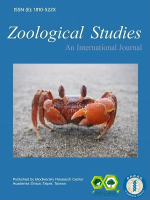“For this study, in addition to museum vouchers, 1437 specimens of Minuca burgersi (Holthuis, 1967) were collected from crab colonies at 105 locations in the western Atlantic Ocean to examine diversity in a species with a large geographic range. Both allometric and geometric morphometry were coupled with the molecular analysis of DNA to give a broader perspective of intraspecific variability in this species. A total of 1153 specimens from the Caribbean Sea and the Atlantic coast of South America demonstrated that M. burgersi from both regions are very similar in their pattern of growth. The average carapace width (CW) for Caribbean is larger than the average for South American males and females. However, size distribution based on CW is unimodal in Caribbean and bimodal in South American populations. The carapace length-width ratio is about 0.68 in females and 0.66 in males. South American males express asymmetric elongation of the cheliped in smaller CW intervals than Caribbean males. In a sample of 259 females, carapace shape is distinct between South American and Caribbean populations. Caribbean populations have less swelling in the branchial regions than South American populations. The swelling correlates primarily with geographic region and to a lesser degree with substrate and salinity. Molecular data from the 16S rDNA and cytochrome c oxidase subunit I (COI) reveal three clades within Minuca burgersi. Two clades are distributed in the Caribbean and the third in eastern South America. The timing of divergence between Caribbean and South American clades is coincident with an increased rate of water and sediment outflow from the Amazon as inferred from the geologic record. Current patterns and associated gene flow within the Caribbean were subsequently influenced by the closing of the Isthmus of Panama. We speculate that various populations may employ different larval dispersion mechanisms resulting in genetic heterogeneity. Consequently, there is considerable biological divergence among populations of M. burgersi in the Caribbean and South America.” The study…

